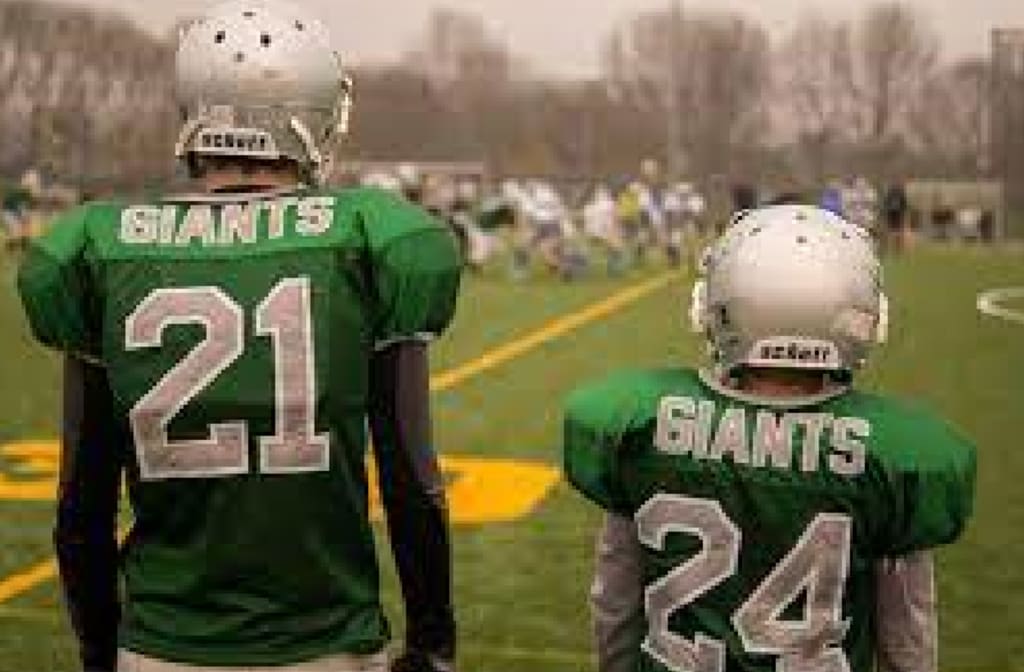Premature Hope
Tales From a Dad with a Whistle: Chapter Six

It was 2016 in Saluda, South Carolina. A week before Spring Break. Anna was as big as a house and we were expecting the boys any day now. Despite her impending childbirth, Anna still worked from time to time, and my teaching schedule hadn’t changed at all. This particular day, around late month-seven of the pregnancy, Anna went to her doctor for yet another check-up. As it turns out, twins can fit in a mother’s stomach any number of ways, and our twins decided to lay one on top of the other, Logan on top and Lukie on the bottom. Now that I think about it, much of this still rings true to what the boys are like today; at any given moment, the boys are probably laying on top of each other right this very moment.
Regardless, the doctor found something that rubbed him the wrong way: Lucas was showing signs of being an IUGR baby. Boiling it down, what this means was that Lukie was woefully undersized because Logan, sitting on top of him in the womb, was stealing all the food and nutrients that Anna provided. Therefore, Logan kept getting bigger, and Luke was falling behind. There was no other choice, the doctor explained: the boys had to come right now. So they scheduled labor inducing for the very next day.
What I didn’t know, at that time, was that Anna was calling my school repeatedly to try to get a hold of me. Saluda, for good reason, had a strict “no personal calls during class hours” policy, so the receptionist at the front desk refused to send her call to my classroom.
“I’m sorry, Mrs. Buffkin, but your husband is teaching a class right now. I can take a message and he can contact you back during his planning period,” she respectfully told my wife.
My wife, ever the quick thinker, took a deep, frustrated breath and calmly spoke into the receiver: “That’s fine. Can you tell him that his wife is in labor and his twins are coming any moment now?”
A long, hesitant moment: “I’ll patch you through to his classroom.”
A quick change in life is not for the weak of heart. For anybody else, this sudden change of direction could have been jarring, terrifying, maybe even destructive. And I’m not afraid to admit that I was a bit terrified in that moment, but thankfully, I was prepared. For months prior, the doctor had warned us that, for lack of a better analogy, twins tended to “cook fast” and to be ready for them to come at any time. Very likely, expect them early. So we did; I had three weeks’ worth of lesson plans prepared for weeks ahead of time, my principals were all aware of an impending early exit, I had lots of leave time saved up, and I had a short-term sub all lined up jump in whenever the need arose. I answered the call, waited for a sub to come relieve me, said goodbye to my students, and I was off.
My mother-in-law got the call, and she was on her way. That night, we took good care of Anna, and the next morning, we escorted her to the finest hospital in the tri-county area. We wheeled her in, took our rooms, and we started praying. Despite the early arrival, everything was falling into place. They would come in, induce her, we’d monitor the contractions, and (hopefully sooner rather than later) Luke and Logan would be in our arms. So the doctor arrived, gave us our pregame speech, gave Anna her injection, and everything else was a waiting game.
And we waited.
And waited.
And the contractions never came.
When the doctor came in, he told us he had warned us that this was a possibility, but the thought had never crossed my mind that inducing a pregnant woman into labor could fail. The doctor told us that time was of the essence, that Luke couldn’t afford to stay in there without the nutrients he needed much longer. He sent us home, with instructions that in 36 hours, we would return and try again. He gave us positions for Anna to lay in, instructions of things we could do to try and move the babies around inside her, to increase the chances of a successful labor when we returned. But in all likelihood, we were looking at a very large chance of a cesarean section.
C-Sections are common, especially with twins, and our doctor was a highly skilled, experienced doctor. This didn’t matter; this was not part of the plan. The plan was 36 weeks minimum, induction, childbirth with a midwife, healthy babies, and success. That was the plan. Anna didn’t want a C-Section; she feared complications. She feared not being able to be with her children after the birth. She feared stupid medical mistakes, or malpractice, or any number of things that can happen with a major surgery. This put Anna, and myself as a result, into a tailspin.
As a coach, I’m overwhelmingly aware of what it feels like to watch the plan go up in smoke. Every football season, you go through summer conditioning, summer practices, 7-on-7 competitions, on into fall camp and the preseason, and you will always have the greatest of ambitions going in. 7-on-7 is passing league, which is just football in gym shorts and two-hand touch. It isn’t real football; you can’t run the ball, so the defense is always in a deep coverage, and the offense is always passing. If you’re successful at all in this league, you go into fall camp thinking you’re better than you actually are. Also, football is always good when it’s a sixteen-year-old versus a squat rack, or offensive packages on air. You always enter the preseason with the thought that “this is our year. This year, we win it all.”
You can help facilitate this by having a plan. The best teams have a plan, and the perennial bottom-dwellers do not. I once got hired to come in and install a spread offense to a struggling small-town team. The first week of spring practice I had scheduled to the minute: we would drill this, then install that, then rep this, then build off that play. Everything was meticulously formulated in the best possible way so as to put in a brand new offense with brand new terminology and concepts these kids had never seen before. I emailed these plans to the head coach, who simply texted me: “Yeah. Good luck with that.”
The day came for the first day of spring practice, and I was waiting with bated breath. Unfortunately, only about half the team showed up on that first day. There were kids on vacation, kids still in the soccer playoffs, weekend league travel ball, kids training for the golf team as they had a tournament on the weekend. A thousand and one excuses. The kids that did show up did not reflect a football team, as the projected starters were all wrapped up in other things, or they were taking a week off since they lost in the baseball tournament the week before. I was only able to install one play that day, and I had to re-install that play the very next week when more kids showed up. I had a plan to install about 75% of the offense that spring, but in actuality, I may have taught them only three plays.
After that first practice, I asked the head coach why things happened this way. He didn’t have an answer, simply saying that this was just the way things were around there. This team, a team that had its glory days back in the late-70’s, had been a middling team ever since, and I had a sneaking suspicion that the way things were had a lot to do with that level of mediocrity.
Good coaches have a plan. Great coaches have a plan for if that plan doesn’t work. My head coach at Waccamaw had a practice schedule followed by a practice schedule in case of a failed wet bulb test and a practice schedule for lightning in the area. One day, a water main burst at the school, and the kids were sent home at noon, with all after school activities shut down. By the time we put the kids on a bus, a schedule was being put in-place to have offensive and defensive Zoom meetings; I mean, even though we couldn’t practice any plays, we were still gonna review last week’s game film, at least.
I know this isn’t all that cut and dry. Good coaches can only add so much to a team; you have to have the Jimmys and the Joes, as well. I’ve seen bad coaches “wing it” and still be successful because they had significantly more talent on the field than their opponent. But what a coach adds to his team is “THE PLAN”. Simply put: good coaches make plans. Bad coaches don’t.
Great coaches have plans for when the first plans go belly-up.
That same year, we installed the spread over the course of the summer. My starting quarterback and slot receiver decided to put on masks and rob a place, so they were unavailable at the start of the season. My starting running back missed most of summer workouts because he spent the entire summer traveling from town to town as a rodeo bull rider. Surprise, surprise: before the first preseason game, he was hurt by one of those bulls and missed the bulk of the season. Our back-up quarterback got drilled in a preseason game where we didn’t have our head coach because his mother got rushed to the hospital. As the first game of the season rolled our way, I had to give my starting right tackle a skill position number and start him at quarterback because he was the only one left smart enough to run the system. I had one viable wide receiver, a tight end who kept getting hurt in weekend travel ball competitions, and a freshman running back with almost no playing experience.
I had a great plan. When that one failed, I had a great back-up. Eventually my back-up, back-up, back-up plan failed, and needless to say, the spread didn’t catch, so to speak. In week two, the head coach went back to the same anemic offense we had before I got there. We won two games that season.
A year prior, our 36 hours were up, and we wheeled Anna back into the hospital in the twilight hours of the early morning. They admitted her, induced her, and a few hours later, as we expected, the doctor came in with the news: no contractions, and the boys needed to come out now. No need for a midwife. The c-section would take place in an hour.
Anna wept, and I consoled her as best I could. She made me swear I wouldn’t leave the boys’ side, and I was left paralyzed with the knowledge that when the nursing staff wheeled our boys out, it was to a place where I couldn’t follow.
They dressed me in piecemeal scrubs, walked me into the operating room, and threatened my life if I moved one step away from Anna’s side. My curiosity couldn’t be stopped, so I peered over the blanket they used to block Anna’s view and I watched the whole procedure take place. I admittedly got queasy when they opened Anna’s belly up, and I was severely grossed out when they plopped the kidney-shaped placenta in the metallic bowl, and it flopped and jiggled around. But one-by-one, exactly one minute apart, we first saw Luke, then Logan. I was able to hold Logan for just a second, and I cried like a baby (Anna was forgivably out of it by that point).
What concerned me most was the army of nurses who flocked around the boys. I wasn’t a medical drama connoisseur, by any means, but I could tell by the way they moved and acted that something was wrong. But in all the chaos, I couldn’t ascertain what it was.
The worst and best part of the preseason is always the hope. You hope the plan will go as expected. You hope that the promise we showed in t-shirts and shorts will reflect when the pads go on. You go to scrimmages and jamborees, you see what the boys look like when they start hitting kids that aren’t wearing the same school colors, and you pray that iron will sharpen iron and that, in the end, the effort they put in will lead to success. Hope can be debilitating, especially when hope is all you have. Watching that hope float away through the cracks of your fingers can be heartbreaking. Every player on every team, without exception, sweats and bleeds and works so that hope will survive, but every game has a winner and a loser. Somebody has to lose.
But hope is still essential.
I was part of a program thankfully on the rise, but with plenty of ground to make-up. A young, energetic, and enthusiastic head coach had a long-term vision of what he knew would bring the program in the right direction. He knew the number one thing the program needed for long-term success was an established feeder program. We had a Varsity of 10th-12th graders and a JV consisting of 7th-9th graders, but we needed a third team, a middle-school only team of 7th and 8th graders, so that those young kids got more playing time and experience to grow into quality Varsity players in the future. The problem would be that doing it on such short notice meant that we would have to demote 10th graders from a Varsity program that was already short on bodies. In making a third feeder team, we were diluting the already short-staffed Varsity even more. But the numbers just worked out on paper, and knowing the importance of taking this next step, the head coach made the call and started developing the plan.
The middle school team went off without a hitch; it was a pain hiring and keeping assistant coaches for the team, but the young man we gave the head coaching role to jumped in head-first and did an admirable job given the struggles and time constraints. A plan was established to divide the Varsity staff such that the JV got equal coaching time and were, more or less, cordoned off from the bigger varsity kids. During the summer, through the preseason and into fall games, the plan was seeming to work. It was through the end of the scrimmages and jamborees into the first game that the cracks in the plan began to shine through. Bumps, bruises, strains, and a few broken bones sat down a number of the players on Varsity, and with the already anemic numbers we had to start the season, we became worried that we wouldn’t be able to field a solid scout team in practice. We were a proud Varsity program struggling to field a full, healthy squad. The plan was failing.
Back in the hospital, Anna had crashed for hours given the little sleep we’d gotten and the amount of sedatives they’d given her, and I got what little sleep I could given the tiny little side-couch they had in the room. When the doctor came into the room, we shook Anna awake. He informed us that despite coming in at right over four pounds, Luke was as healthy as he could be expected to be. He was going to be admitted into the natal intensive care unit simply based on his size alone, but there was no reason to be worried assuming he would take milk normally and start packing on some weight. Logan, on the other hand, was a different story. Despite coming in at over six pounds, Logan was the far greater concern; his lungs hadn’t developed and matured to the point that he could breathe on his own, so he was rushed to the NICU and put on a ventilator. Between the two boys, we were looking at an extended stay in the NICU.
Every worry that Anna had ever conceived of became reality in that moment. We weren’t allowed to see the boys for over nine hours after they were born. Logan was struggling for air and we were barred from entering the room. All we could do was wait. The plan was shattered, gone. There was no alternative plan. We were forced to “wing it”, and it terrified the both of us.
But we still had hope.
Anna, determined to see her babies, demanded to see them as soon as possible, even with her guts barely stitched together. “I understand,” a sympathetic nurse told her, “but you just had major surgery.”
“I don’t care. I need to see my babies,” Anna demanded.
“Okay, okay…,” the nurse patted her leg, “I’ll tell you what. I have some good medicine. It’ll knock that pain down and soothe you real nice-like, and you can see them first thing in the morning.”
The look on Anna’s face showed her deep dissatisfaction with the nurse’s answer.
The nurse continued, “Or…or… I can give you ‘the good stuff’. The REAL good stuff. The stuff they give the divas when they gotta go on-stage TONIGHT kinda stuff. Now I’ll warn you; it’ll make you so nauseous that you’ll pray for death, but you’ll get to see your babies tonight.”
“Give me the good death stuff,” Anna demanded. That night, Anna held and breast-fed Lucas for the very first time. In her other hand, a small waste basket she filled with vomit every other second. She stands by the fact that to her, it was worth it.
The hospital was amazing; they had empty rooms in another wing, so when Anna was discharged from the maternity ward, they moved us into an empty room just a three minute walk from the NICU. Anna’s mother ran errands for us, brought us meals; she stayed with Anna a few nights just to let me come home to get a full night’s sleep. The nurses helped Anna start the process of pumping and building a solid supply of breast milk, a process that I didn’t even dream would be as difficult as it was. We stayed at the hospital for fourteen days. Luke had put on several ounces and was keeping his core temperature; nine days in, Luke was discharged to sleep with us in our hospital room. On day ten, Logan was able to breathe on his own, his ventilator was removed, and I held and bottle fed him for the first time out of the bubble. On the evening of day fourteen, both boys passed their carseat tests, and we said goodbye to the hospital and hello to their beautiful nursery at home.
One long fall afternoon, as the practice sideline resembled less of a football team and more of a medical triage unit, the plan to separate the JV from the Varsity was looking less and less effective. My head coach asked me what I’d done in my past experiences when we came across this problem. The plan was failing- had failed- and something new had to happen if there was any chance to find success in our current standing. I had- still have- a lot of respect for this head coach, and I revered the hard work and the planning he’d put into building this program up. I told him I’d crossed this bridge before: low numbers, heavy injuries, and still trying to build for the future.
I told him that iron sharpens iron. Players make each other better. There had been such an effort put into making the JV and Varsity practices separate but equal, protecting the JV players from the big, bad, scary upperclassmen and keeping skilled players off the field. That needed to end. “Let the JV service the Varsity, and vice-versa. Put the best JV offense against the ones on Varsity defense. Run the Varsity offense against the JV’s ones on defense. Make them make each other better. They play separate games, but they are still one team. We’ll have a great scout team for the Varsity, and the JV will get better and better against tougher kids. I mean, playing another JV squad is easy when you’ve been butting heads with the Varsity all week, right?”
So he went to his office and started building a new plan.
The next day’s practice saw the two squads come together. Both teams got the same quality coaching in individual drills, just together now. In small groups, both squads competed against one another. In team, a young squad of talented scouts competed against the Varsity offense, and then the JV offense, and again with Varsity, and again with JV. The practice ran smoother, the intensity was up, the kids laughed and smiled through the sweat, and everyone got better.
Iron sharpens iron. And now, we have hope.
So what does hope look like when the plan goes belly-up? On the sideline, Friday night, the band is thumping. The cheerleaders are cheering. The concession stand is pumping out hot dogs and popcorn. The players are huddled together in warm-ups, hyping each other up, rocking back and forth like the pulse of one heartbeat. And there I stand, looking at my young men, proud of what they’ve developed into, ready for competition. And then I turn to the home stands. Second section from the right, about midway up, Anna shows obvious signs of frustration, part of her ready for kick-off, and the other part of her trying not to yell at Luke and Logan, to her right, swinging from the handrails in the stands, desperately wanting to run out into those fields and play with the other, bigger kids. I look at her, and she at me, and she smiles. And waves. She hollers something at the boys, and they turn. Look. They scream “Hey Daddy!” as they jump up and down in the stands. I wave back, smile, and grab for my whistle.
That’s what hope looks like.
About the Creator
Bryan Buffkin
Bryan Buffkin is a high school English teacher, a football and wrestling coach, and an aspiring author from the beautiful state of South Carolina. His writing focuses on humorous observational musings and inspirational fiction.
Enjoyed the story? Support the Creator.
Subscribe for free to receive all their stories in your feed. You could also pledge your support or give them a one-off tip, letting them know you appreciate their work.






Comments
There are no comments for this story
Be the first to respond and start the conversation.